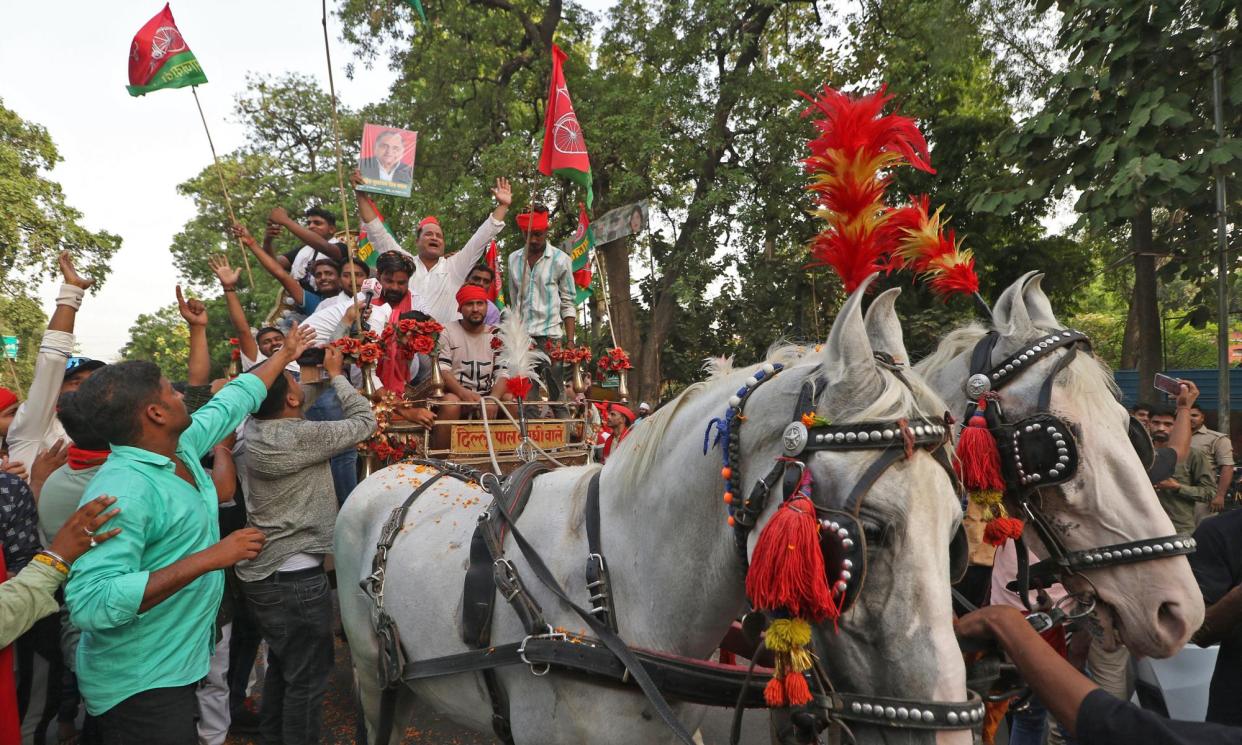How voters turned against Narendra Modi in his party’s heartland

It was less than six months ago that Narendra Modi walked solemnly through the ornate surroundings of the Ram Temple in Ayodhya, in Uttar Pradesh, India’s most populous state and one of its most politically crucial. His appearance in the holy city to inaugurate the newly constructed Hindu temple, built on the ruins of a mosque demolished two decades earlier, was cast as the pinnacle of the prime minister’s decade in power – the crowning glory of his Hindu nationalist agenda and his ticket to a third term in office. The ceremony was deemed to mark the unofficial launch of his election campaign.
Related: Modi inaugurates Hindu temple on site of razed mosque in India
But on Tuesday evening Modi was faced with a rude awakening. His Bharatiya Janata party (BJP), which has ruled India with an iron grip for a decade, has lost its majority as a single party and will have to rely on coalition partners to return to government. The losses were particularly heavy in Uttar Pradesh, long considered to be the BJP’s bastion – and nowhere more so than in Ayodhya.
In the aftermath, few could believe that Ayodhya, the city that had become so closely aligned with Modi’s agenda, could reject the prime minister’s party.
Yet the frustrations that led to the BJP losing the Faizabad seat are ones reflected across the state: religious polarisation and pride in the Ram Temple ultimately did not trump anger at rampant unemployment, stagnant wages, and unaffordable inflation. “Bhookai piat Bhajan nahi hota [Prayers are not offered by those with hungry stomachs],” became a commonly heard refrain.
Many people also expressed anger at the party’s heavy-handed approach to India’s institutions, including the media, which presented an almost uniformly pro-government narrative throughout the election.
Among those in Ayodhya who voted against the BJP was Azaan Ahmad Khan, 36, who runs a clothing business. He was “fed up with the dictatorial attitude of the Modi government”, he said, and like most of the city’s people voted for the Samajwadi party, a regional party that is part of the opposition INDIA coalition.
“This government failed to provide jobs or uplift the poor. Instead they started talking about changing the constitution,” said Khan. “I was not very active about political issues previously. But the way Modi has polarised society, people like me worry about the future.”
Khan was not alone. While the newly constructed Ram Temple was a point of pride for many in Ayodhya, there was also an overwhelming sense that it was “for outsiders”, and many complained that religion was no replacement for failures of governance and job creation for people living there.
Related: Narendra Modi loses aura of invincibility as predicted landslide fails to materialise
“Building the Ram temple will not help me get a job. What will I do with the temple without a job?” said Raj Yadav, 29, who runs a cosmetics store in Ayodhya. He was frustrated that the BJP had not tackled unemployment and inflation and said that recruitment for jobs was “a complete mess”. “The BJP do not have any vision for the actual development of the country,” he said.
Yadav was among those who said that comments made by the local BJP candidate during the campaign, that the party wanted a large majority in order to rewrite India’s constitution, had turned off many. The state of Uttar Pradesh is home to many lower caste communities who began to widely fear that re-writing of the constitution would mean the removals of their protections enshrined in it.
“People, particularly those from lower castes, were shocked and angry at those comments,” he said. “The constitution became the biggest issue here among the Hindus, Muslims and everyone else.”
Modi’s Hindu nationalist agenda was seen as a powerful tool for him to win votes in the Hindi heartland. Yet many in Uttar Pradesh spoke of their disgust at the prime minister’s seemingly increasingly anti-Muslim rhetoric out on the campaign trail.
Purvi, who uses a single name, a 35-year-old teacher from the Uttar Pradesh region of Azamgarh, said she had voted for Modi in the last election, swayed by his image as a strongman leader. This time, she voted for the Samajwadi party, accusing Modi of “polarising the nation”.
“Every day, my Muslim friends feel intimidated by the hate that Modi and his party associates propagate,” said Purvi. “How can I vote for the party whose leaders call Muslims infiltrators, terrorists, those who breed more? We have never seen a government so dangerous for the foundation of this nation and particularly for its minorities.”
Even in the prime minister’s constituency of the holy city of Varanasi, also in Uttar Pradesh, Modi’s sheen appeared to have faded, and his victory margin went from almost half a million votes in 2019 to 150,000 on Tuesday.
The disenchantment was summed up by Sushmita Singh, 54, a government employee who voted for Modi in the past two elections, believing he would bring prosperity. This time round, she voted for Congress, India’s largest opposition party also part of the INDIA coalition, angry at the animosity she felt was being stirred up between Hindus and Muslims and the government’s failure to create good jobs for the growing youth population.
“People affiliated with the BJP get VIP treatment in Varanasi, while ordinary people suffer and are mistreated,” said Singh. “The BJP is increasing its influence and behaving like colonial rulers.”
She added: “If a place like Varanasi, where the prime minister himself gets elected for the parliament, has not developed much in the last 10 years, then there is not much reason for me to believe Modi’s promise of the development of our country.”

 Yahoo News
Yahoo News 
